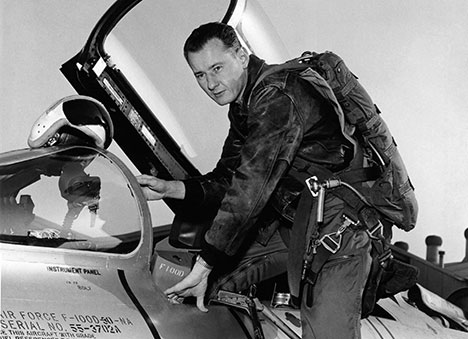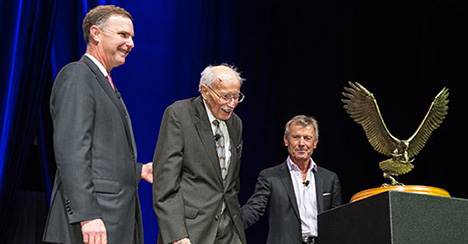
February 1, 2017
The greatest pilot ever was a kind, unassuming gentleman who inspired multiple generations of aviators.
To call R.A. “Bob” Hoover the “gentleman pilot” seems both the most fitting description of his unassuming presence, and yet wholly inadequate in measuring his impact upon tens of thousands of people in aviation worldwide.
Those who met Hoover, who died Oct. 25 at the age of 94, quickly learned two important things: He made you believe that you were the most important person in the room, and you invariably left with a story to tell. Hoover will be forever remembered not only for his significant aerial accomplishments, but also as a man always willing to share his experiences and wisdom with others.
“Bob Hoover is clearly recognized by many people as the greatest pilot who ever lived,” said NBAA President and CEO Ed Bolen, “but he was an even better person. He had a genuineness about him, a grace and humility that belied his accomplishments. Here was someone who flew with Charles Lindbergh, and yet he always had time for anyone who wanted to talk with him.”
A Hero in Combat
Born Jan. 24, 1922, in Nashville, TN, Hoover had a long and distinguished aviation career, first as a combat aviator during World War II, then serving as a military and civilian test pilot.

Fellow aviation pioneer Jimmy Doolittle called Hoover “the greatest stick-and-rudder man who ever lived.”
During World War II, Hoover was shot down and spent 16 months as a prisoner of war before commandeering a German fighter aircraft to escape to Allied-controlled territory. After the war, Hoover evaluated captured enemy aircraft and flight-tested U.S. combat airplanes, including the first jets.
As an alternate pilot for the supersonic Bell X-1, Hoover flew the chase plane when Chuck Yeager broke the sound barrier in 1947. In the preface to Hoover’s autobiography “Forever Flying,” Yeager called Hoover “the best pilot I’ve ever seen.”
After leaving the U.S. Air Force in 1948, Hoover became a civilian test pilot for North American Aviation and Rockwell International for more than three decades. Considered a founder of modern aerobatics, Hoover is arguably best known for his jaw-dropping aerial demonstrations in his P-51 Mustang fighter and Shrike Commander business aircraft.
“I met Bob Hoover for the first time in the late 1980s at an air show,” recalled Patty Wagstaff, aerobatics champion and air show performer. “I had just started flying some larger shows, and after I flew, Bob came over and introduced himself, and welcomed me to the air show world. It’s hard to underestimate the importance of what he did that day for a young, shy and very new air show pilot, and over the years I witnessed this type of inclusive, kind and thoughtful behavior from Bob many times.”
Connecting to Thousands
For all of Hoover’s many accomplishments in the air, his most lasting influence will be his connection to thousands within the aviation community, including business aviation.

“I first met Bob in 1991,” recalled Andrew Broom, executive director of the Citation Jet Pilots Owner Pilot Association. “In the last few years, I got to spend more time with him, and he counseled me on different aspects of my career. I didn’t realize back in the 1990s who I was getting to know, but having that time with him over the past few years was incredible.”
“Bob was an unbelievable guy, very personable, open and willing to tell his story,” said Mark Chaney, CAM, senior aviation director at Coca-Cola. “He’s considered the greatest pilot that ever was, but he was also an ambassador for our industry. He would travel around the country to sit with a group of aviators and tell stories. And he never told the same story twice.”
“Anyone who spent time around Bob recognized that, way beyond his legacy as an aviator, he was the ultimate ambassador for aviation,” said aviation photographer Paul Bowen. “I first met Bob in 1976 at Oshkosh. I was just a young photographer, [but] he made me feel like I was the most important person he would meet that day.”
Inspiring Future Generations
That personal connection is a recurring theme in conversations about Hoover. “Meeting him was a turning point in my life,” recalled Marlin Priest, CEO of Pioneer Aviation Management and a member of the NBAA Maintenance Committee. “I had the opportunity to go to Oshkosh with some friends, and Hoover actually invited us to come across and clean Ole Yeller [Hoover’s bright yellow P-51] after the air show.
“For a 19-year-old kid, it was a dream come true,” Priest continued. “Years later, I met him again at an NBAA event where he spoke about the need to give back to the industry. I introduced myself and said, ‘I need you to understand I was one of those kids you reached out to, and you changed my life forever.’”
King Schools founders John and Martha King described Hoover’s lasting influence on the training community. “We know of instances where he found out someone was a brand-new flight instructor, and he sat them down while he was in the middle of signing books,” Martha said. “He told them, ‘Sit here and talk to me, there are things I need to tell you about being a flight instructor.’ What wonderful sharing he did of his knowledge and wisdom.”
“Bob was just great company,” added John King. “Just lots of fun, with great stories and a sense of humor. He was a wonderful storyteller… [and] every story was something you could learn from.”
After meeting Hoover briefly at a 1999 air show, ConSeaAir CEO Rick Croasdale had the unexpected opportunity to spend more time with Hoover at the 2007 NBAA Schedulers & Dispatchers Conference. “I was late to lunch,” Croasdale recalled. “I found a table, and there was Bob Hoover seated to my left. What stuck with me most is that it didn’t matter who he was talking to; he had an instant connection with anyone who shared his passion for aviation.”
A Legacy of Giving
Perhaps above all, Hoover will be remembered for his eagerness to share his knowledge. “Bob was the ultimate professional,” said Bowen. “He was a truly kind gentleman, and he gave back. He was a great mentor to so many.”
Ron Kaplan, enshrinement director for the National Aviation Hall of Fame (NAHF), recalled a conversation Hoover had with Kaplan’s 14-year-old son at the Reno Air Races a few years ago. “Bob was having an intense, one-on-one discussion with my son, Max.
Afterwards, Max asked if he could borrow my laptop,” Kaplan continued. “He said, ‘I want to write down everything Bob told me so I don’t forget it.’ Bob’s legacy is that he served in that capacity for thousands of young people.”
“Bob’s influence on aviation is important because he always lived up to and, in fact, exceeded his public image,” Wagstaff added. “There was nothing phony about him. He was the real deal – the one-and-only Bob Hoover.”
“Bob Hoover was the pilot’s pilot,” declared Greg Herrick, president of the Aviation Foundation of America, “I can’t think of someone more respected by the pilot population as a whole.”
Bolen suggested that today’s aviation professionals should continue Hoover’s legacy through their own outreach efforts. “Bob Hoover was never too busy to take the time to talk to someone, to tell a story, or ask about others,” he said. “In that way, he made us a tighter community. I think we owe it to him to continue to build on what he started.”
Bolen noting that acclaimed aerobatic pilot Sean Tucker once said, “Bob was the world’s best example of always being the best example possible,” added, “He was a brilliant example of a human being and an aviator, and he spoke to all that is best about humanity and our industry.”
Learn more about Bob Hoover at The National Aviation Hall of Fame.
Many Other Awards and Achievements
Hoover’s other accolades include:
- National Aviation Hall of Fame enshrinement (1988)
- Living Legends of Aviation Freedom of Flight Award, later renamed the Bob Hoover Freedom of Flight Award (2006)
- The Smithsonian’s National Air and Space Museum Trophy (2007)
- National Aeronautic Association Wright Brothers Memorial Trophy (2014)
For his military service, Hoover also received the Purple Heart, Air Medal with Clusters, the Distinguished Flying Cross, the Soldier’s Medal for Valor, and France’s Croix de Guerre.
Following a serious misfueling accident in his piston-engine Shrike Commander, Hoover promoted the flattened “Hoover Nozzle” for turbine-engine aircraft. Used in conjunction with the “Hoover Ring” mounted on many modern aircraft powered by Jet A, the system is designed to prevent similar incidents.

An NBAA Meritorious Service to Aviation Award Winner
In 2014, NBAA bestowed its highest honor, the Meritorious Service to Aviation Award, upon Bob Hoover in recognition of his numerous contributions to the industry that he so loved, and which loved him back.
“Bob Hoover is well established as one of the world’s most accomplished aviators,” said NBAA President and CEO Ed Bolen at the time Hoover won the award. “He has been an inspiration to multiple generations of pilots, including business aviators, and has been an active participant in NBAA’s convention for many years.”
Business aviation’s most distinguished honor, the Meritorious Service to Aviation Award recognizes extraordinary lifelong professional contributions to aviation. In addition to Hoover, past recipients have included astronaut Gene Cernan, golfing legend and acclaimed pilot Arnold Palmer, and Experimental Aircraft Association founder Paul H. Poberezny.


 International Business Aviation Council Ltd.
International Business Aviation Council Ltd.